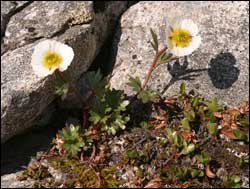Over half the plant species in Europe at risk because of climate change

Ranunculus glacialis photo: Uwe Lochstampfer <a target=_blank href=http://www.botanikus.de >www.botanikus.de </a>
Over half of all plant species in Europe are at serious risk because of climate change. This is the finding of an international team of scientists working on the ALARM project led by the Centre for Environmental Research in Leipzig-Halle (UFZ). Preliminary findings have recently been presented in connection with the UN Conference on Biological Diversity in Curitiba, Brazil.
The situation is expected to become particularly dramatic at middle to high altitudes in mountainous areas. The mountain flora there is very specialised and would therefore be less able to adapt. As well as the Alps and Pyrenees, this primarily affects large stretches around the Mediterranean and in Eastern Europe. The loss of species diversity would be less severe in Scandinavia and along the Atlantic. The scientists assessed the impact of various climate forecasts on 1350 European plant species. The climate forecasts assume an increase in carbon dioxide concentration in the atmosphere to up to twice today’s values and a rise in the average temperature of up to 4 degrees by 2080.
ALARM is one of five research projects with a total budget of 60 million euros, which the EU delegation presented at a meeting of the Biodiversity Convention in mid March 2006. Dr. Josef Settele from the UFZ is a member of the delegation and in Curitiba he reported on the content and interim results of the ALARM research project which he coordinates. The project focuses in particular on four areas which are thought to play a role in the loss of biological diversity: climate change, the loss of pollinators like bees, bumblebees and butterflies, harmful substances present in the environment and the invasion of non-native animal and plant species. The scientists work in over 40 different research regions spread across the whole of Europe and South America. By the end of the project in 2009, the project initiators expect fundamental advances in knowledge – in particular because of the unparalleled scale and complexity of the investigations.
In the run-up for the meeting of the Biodiversity Convention, the Environment Council of the European Union released a statement stressing the need to intensify biodiversity research, and pointing out that biodiversity monitoring is a central component for achieving the aims of the Biodiversity Convention. The participants at the 1992 UN Environment Summit in Rio de Janeiro resolved to achieve a significant reduction in the rate of destruction of the environment and loss of biodiversity by 2010.
From the 20th to the 31st of March the 8th UN Conference of the Parties to the Convention on Biological Diversity (COP 8) was held in Curitiba in Southern Brazil. The Convention on Biological Diversity (CBD) aims at the protection of species diversity on Earth. Biological diversity includes the genetic diversity within individual species, species diversity and the diversity of ecosystems. The convention has been signed by 187 states and by the EU.
Media Contact
More Information:
http://www.ufz.deAll latest news from the category: Ecology, The Environment and Conservation
This complex theme deals primarily with interactions between organisms and the environmental factors that impact them, but to a greater extent between individual inanimate environmental factors.
innovations-report offers informative reports and articles on topics such as climate protection, landscape conservation, ecological systems, wildlife and nature parks and ecosystem efficiency and balance.
Newest articles

Pinpointing hydrogen isotopes in titanium hydride nanofilms
Although it is the smallest and lightest atom, hydrogen can have a big impact by infiltrating other materials and affecting their properties, such as superconductivity and metal-insulator-transitions. Now, researchers from…

A new way of entangling light and sound
For a wide variety of emerging quantum technologies, such as secure quantum communications and quantum computing, quantum entanglement is a prerequisite. Scientists at the Max-Planck-Institute for the Science of Light…

Telescope for NASA’s Roman Mission complete, delivered to Goddard
NASA’s Nancy Grace Roman Space Telescope is one giant step closer to unlocking the mysteries of the universe. The mission has now received its final major delivery: the Optical Telescope…



